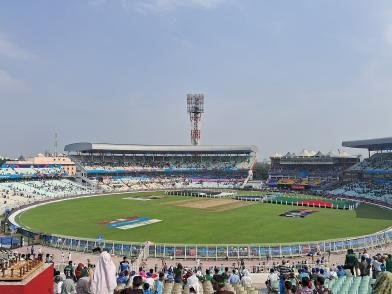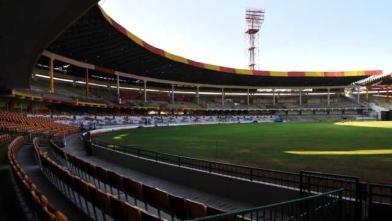The Pulse of Indian Cricket
Welcome to the beating heart of cricketing fervor in Bengaluru – the M Chinnaswamy Stadium. This isn’t just a venue; it’s a living testament to India’s love affair with cricket, pulsating with electrifying energy, unforgettable moments, and a legacy that spans decades. Renowned as a premier Cricket Stadium India has to offer, it’s celebrated for its high-scoring spectacles, passionate crowds, and cutting-edge innovation. It stands as the pride of Karnataka and the fortress of Royal Challengers Bangalore (RCB). Whether you’re an RCB loyalist chanting “Kohli! Kohli!” or a cricket purist savoring a Test match’s ebb and flow, this guide unveils everything you need to know about this legendary cricket ground.
History of M Chinnaswamy Stadium
The roots of M Chinnaswamy Stadium trace back to 1969, when the Karnataka State Cricket Association (KSCA) envisioned a world-class cricket venue for Bengaluru. The land, originally a dumping ground near Cubbon Park, was leased from the Karnataka government with a mission to transform it into a sporting hub. Construction began in 1970 under the stewardship of Mangalam Chinnaswamy, a Mandya-born lawyer who served as KSCA Secretary and later BCCI President (1977-1980). His dedication to cricket’s growth earned the stadium its name posthumously.
The first First-class match arrived in the 1972-73 season, pitting Karnataka against Tamil Nadu. By November 22, 1974, it earned Test status with a gripping India vs. West Indies clash – a game that introduced Viv Richards and Gordon Greenidge to the world stage. Over the years, it’s been a backdrop to cricketing history: Anil Kumble’s 10/74 against Pakistan in 1999, India’s 1996 World Cup triumph over Pakistan, and Sachin Tendulkar’s emotional farewell Test in 2013. The stadium also faced challenges, like the 1996 World Cup semifinal abandonment due to crowd unrest after India’s collapse against Sri Lanka, adding a layer of raw emotion to its legacy.
Location and Accessibility
M Chinnaswamy Stadium sits at Queens Road, near Mahatma Gandhi Road, Shivaji Nagar, Bengaluru, Karnataka 560001, in the heart of Bengaluru’s bustling central district. Its proximity to green expanses like Cubbon Park and commercial hubs like MG Road and Brigade Road makes it a landmark in the city’s cultural and sporting fabric.
- By Road: Taxis, auto-rickshaws, and app-based cabs (Ola/Uber) are plentiful, though match-day traffic around MG Road and Residency Road can slow you down. Plan for an extra 20-30 minutes during peak cricket events.
- By Metro: Bengaluru’s Namma Metro Purple Line is a game-changer. Alight at Cubbon Park Metro Station (800 meters away) or Mahatma Gandhi Road Metro Station (1 km), followed by a 10-15 minute walk through tree-lined streets.
- By Rail: Bangalore Cantonment Railway Station (4 km) is the nearest, offering connectivity to major Indian cities. From there, a quick auto or metro ride gets you to the stadium.
- By Air: Kempegowda International Airport, 35 km north, serves domestic and international flights. Prepaid taxis or cabs take 1-1.5 hours, while the airport’s Vayu Vajra bus to Majestic (Kempegowda Bus Stand) connects to the metro for a budget-friendly route.
- Nearby Landmarks: Besides Cubbon Park, you’re close to the Karnataka High Court, Vidhana Soudha (state legislature), and the lively Church Street dining scene.
Architecture and Design
Designed with a capacity of 40,000, M Chinnaswamy Stadium offers a compact yet dynamic layout. Its circular design, inspired by classic amphitheaters, ensures no seat feels too far from the action – a rarity among larger cricket venues. The field dimensions are batter-friendly, with boundaries ranging from 50-65 meters, and Bengaluru’s high altitude (900 meters above sea level) gives the ball extra carry, delighting power hitters.
The pitch is a star in itself: flat and true, it’s a paradise for stroke-makers in white-ball cricket, though early moisture in Tests aids seamers, and wear later assists spinners. The subair drainage system, installed in 2012, is a technological marvel – sucking water out in 10-15 minutes post-rain, a feat that saved countless matches. Architecturally, the stadium’s sustainability shines with solar panels atop the stands, installed in 2015, generating 600,000 units of electricity yearly and powering 90% of its operations. The designer, though not widely credited, worked under KSCA’s vision to blend functionality with Bengaluru’s progressive ethos.
Famous Matches and Events
M Chinnaswamy Stadium has hosted cricketing epics across formats:
- 1974 Test (Nov 22-27): India vs. West Indies – a draw, but the debut of Viv Richards (192*) and Gordon Greenidge set the tone for their legendary careers.
- 1996 World Cup Quarterfinal (Mar 9): India’s 39-run win over Pakistan, with Navjot Sidhu’s 93 and Venkatesh Prasad’s fiery 3/45 under floodlights.
- 1999 Test (Feb 2-6): Anil Kumble’s 10/74 vs. Pakistan – a one-man demolition that leveled the series and etched his name in cricket history.
- 2011 World Cup (Feb 27): India vs. England tied at 338, with Andrew Strauss (158) and Sachin Tendulkar (120) starring. Days later, Kevin O’Brien’s 50-ball 113 led Ireland to a stunning upset over England.
- IPL 2013 (Apr 23): Chris Gayle’s unbeaten 175* off 66 balls powered RCB to 263/5 against Pune Warriors – the highest T20 individual score ever.
- 2013 ODI (Nov 2): Rohit Sharma’s 209 off 158 balls, including 16 sixes, crushed Australia in a 57-run win.
Records abound: highest Test score (676/7 by India vs. Sri Lanka, 1988), most IPL sixes in a season, and more. Beyond cricket, the stadium has welcomed concerts (like AR Rahman’s in 2016) and ceremonial events, showcasing its versatility.
Facilities
M Chinnaswamy Stadium caters to everyone:
- Spectators: Seating spans budget-friendly stands to plush corporate boxes with air-conditioned lounges. Food courts serve South Indian staples (dosa, idli), burgers, and snacks, though prices are steep (₹100-300 per item), and outside food is banned. Restrooms are well-maintained, and giant LED screens ensure you miss nothing.
- Parking: Limited to 500-700 vehicles; nearby lots at Cubbon Park or MG Road are alternatives, but public transport is smarter on match days.
- Players: Spacious dressing rooms with recovery areas, indoor nets, and a gym keep teams match-ready. The groundskeeping crew, armed with cutting-edge tech, maintains the pristine turf.
- Media: A 200-seat press box, high-speed Wi-Fi, and broadcast towers support global coverage, making it a favorite for TV crews.
Unique Features
M Chinnaswamy Stadium stands out with:
- Eco-Friendly Edge: The first cricket stadium to adopt solar power on a massive scale, cutting its carbon footprint significantly.
- Rahul Dravid Wall: A 10,000-brick mural near Gate 18, unveiled by Sachin Tendulkar in 2012, honors Dravid’s 10,000+ runs in Tests and ODIs – a nod to Bengaluru’s “Wall”.
- Floodlights: Four towering pole-type lights, upgraded in 2009, deliver crisp visibility for night games, a rarity when introduced in the 1980s.
- Fan Zones: Interactive areas with trivia, merchandise stalls, and photo ops amplify the excitement, especially during IPL.
Upcoming Events
2025 promises excitement:
- IPL 2025 (Mar-May): RCB’s home fixtures, likely featuring Virat Kohli’s fireworks. Schedule TBD – check KSCA or RCB’s site.
- Domestic Cricket: Ranji Trophy and Syed Mushtaq Ali games possible in late 2025.
- Tickets: Book via BookMyShow, Paytm, or RCB’s portal (₹1,500-₹18,000). Offline counters open a week before big games, but online is safer.
Fan Experience
Fans describe it as “cricket heaven.” The compact stands amplify every cheer, especially when RCB’s “12th Man Army” erupts in red. One visitor recalls, “I saw Kohli’s 82* against Gujarat Lions in 2016 – the noise was deafening!” Another says, “Tests here feel sacred; IPL feels like a festival.” From kids waving flags to seniors reminiscing Kumble’s feats, the atmosphere blends nostalgia with raw energy. Rain delays spark impromptu chants, and sixes ignite firecracker-like roars.







